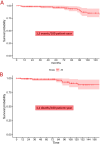Hypertrophic cardiomyopathy due to truncating variants in myosin binding protein C: a Spanish cohort
- PMID: 39581692
- PMCID: PMC11590831
- DOI: 10.1136/openhrt-2024-002891
Hypertrophic cardiomyopathy due to truncating variants in myosin binding protein C: a Spanish cohort
Abstract
Background: Hypertrophic cardiomyopathy (HCM) is an inherited disorder whose causal variants involve sarcomeric protein genes. One of these is myosin-binding protein C (MYBPC3), being previously associated with a favourable prognosis. Our objective is to describe the clinical characteristics and events of a molecularly homogeneous HCM cohort associated with truncating MYBPC3 variants.
Methods and results: A cohort of patients and relatives with HCM diagnosis and carrying a truncating MYBPC3 variant were retrospectively recruited. Subjects had an average follow-up of 7.77 years, with an incident HCM phenotype of 10%. They were middle-aged adult patients (47±16.8 years) without significant comorbidities or symptoms. Hypertrophy was discrete with a significative difference between probands and relatives (17.5±4 mm vs 14.6±5 mm; p<0.0001). Ejection fraction was predominantly preserved (65%±10%). Despite it being the most common clinical event, relevant heart failure (observed in 8.1% of patients) was infrequent and commonly found in the presence of a second environmental precipitating agent. ESC-HCM risk calculator and modifier factors did not correlate with the risk of major events predicting events, which were low (1.51 per 100 patients/year) and associated with the severity of HCM, abnormal QRS in the ECG and age. Genetic factors and sex were not associated with major events.
Conclusions: This is the first molecularly homogeneous, contemporary cohort, including HCM patients secondary to MYBPC3 truncating variants. Patients showed a good prognosis with a low event rate. In our cohort, major arrhythmic events were not related to measured environmental or genetic factors.
Keywords: Cardiomyopathy, Hypertrophic; Genetic Diseases, Inborn; HEART FAILURE.
© Author(s) (or their employer(s)) 2024. Re-use permitted under CC BY-NC. No commercial re-use. See rights and permissions. Published by BMJ.
Conflict of interest statement
Competing interests: RB has received consultant/advisor fees from Cytokinetics, Bristol Myers Squibb, Pfizer, Alnaylam; and research grants from Sanofi and Bristol Myers Squibb. JAPD received advisory fees from Bristol Myers Squibb. There are no other relevant relationships with the industry.
Figures


